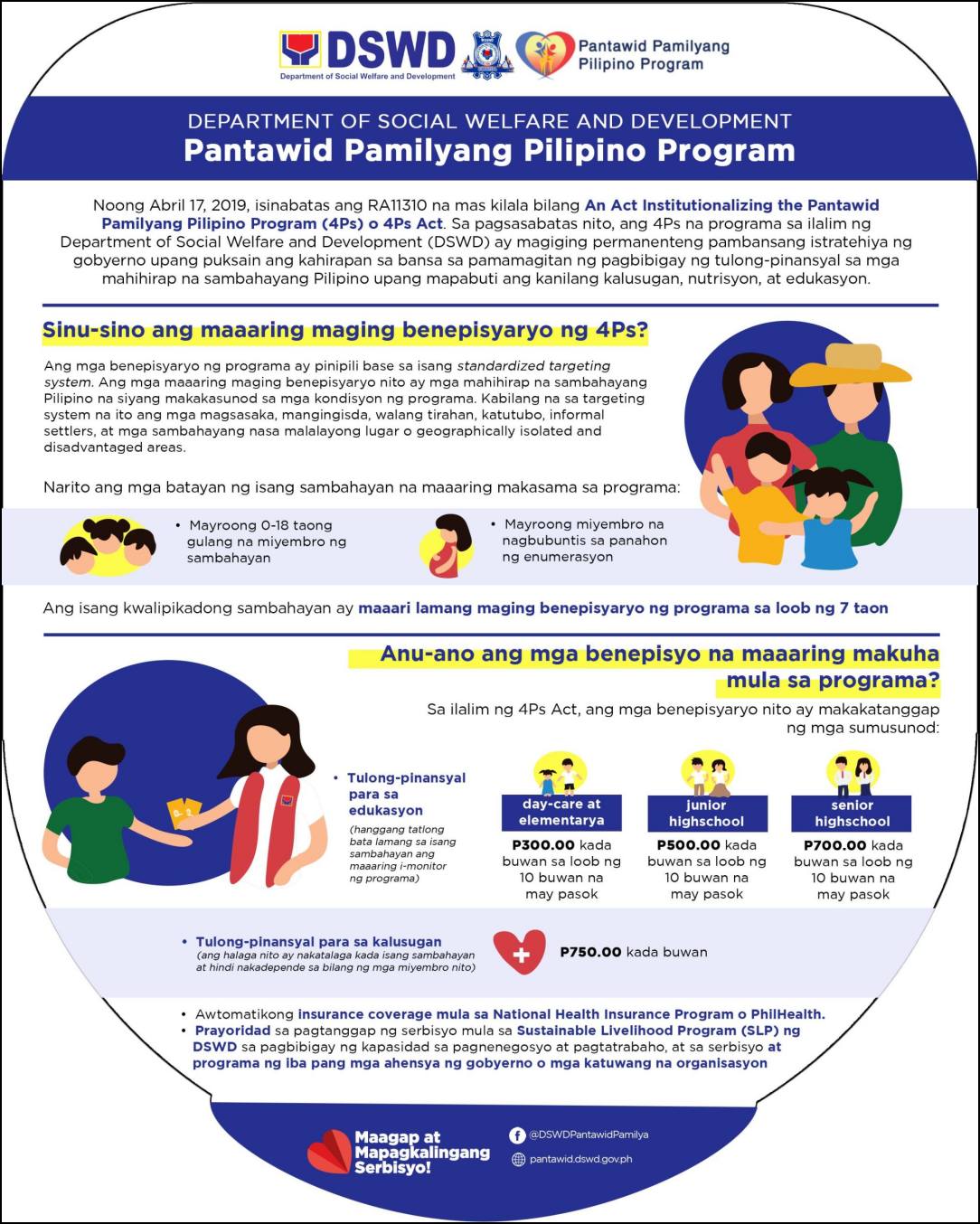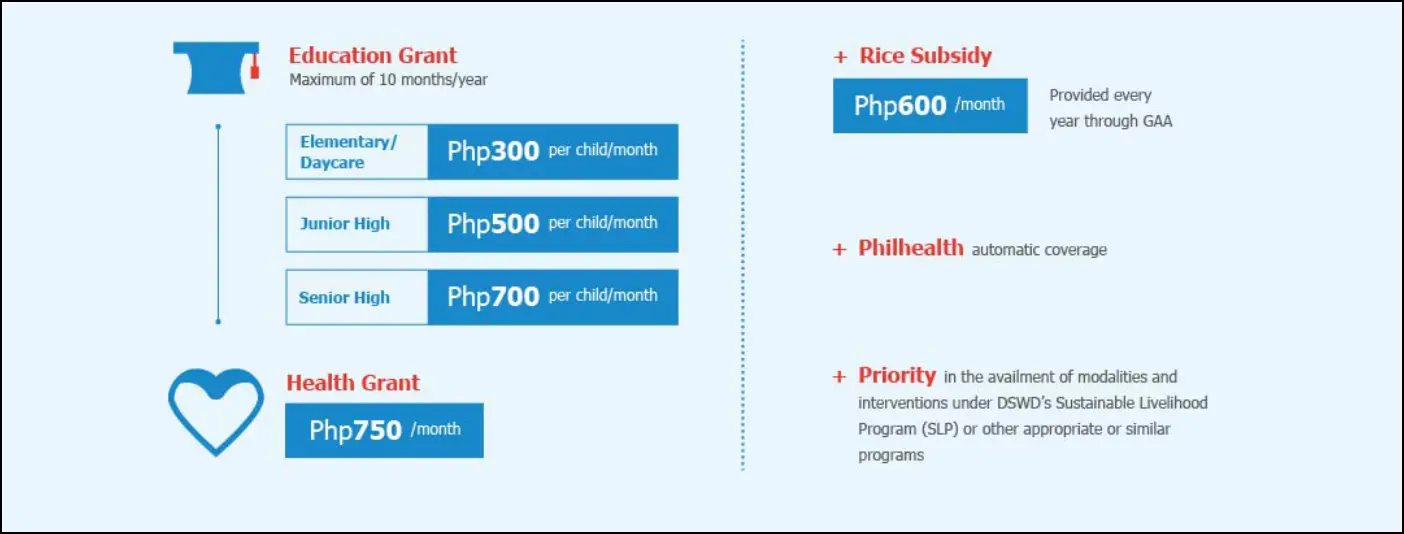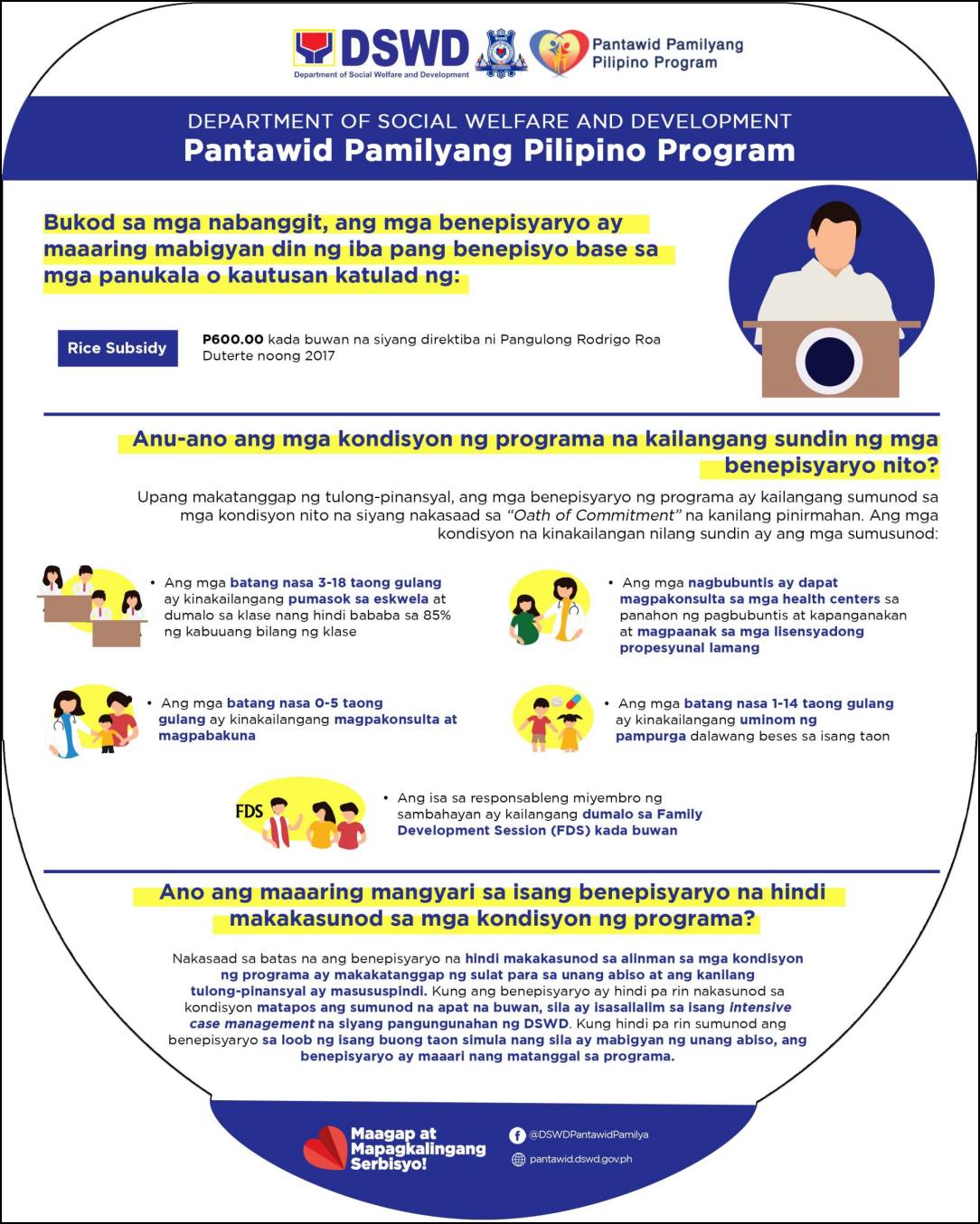The Pantawid Pamilyang Pilipino Program (4Ps) is a groundbreaking poverty alleviation initiative implemented by the Department of Social Welfare and Development (DSWD) in the Philippines. Launched in 2007, the program aims to break the cycle of intergenerational poverty by investing in the health, nutrition, and education of Filipino children from low-income families.
Also read: How to Apply DSWD Medical Cash Assistance in Cebu
The 4Ps Program is based on the conditional cash transfer model, wherein financial assistance is provided to eligible households that comply with specific conditions related to healthcare, nutrition, and education. This approach encourages families to prioritize their children’s well-being, ensuring better access to essential services and promoting long-term human capital development.

The 4Ps Program has been successful in improving the lives of millions of Filipino families, contributing to a reduction in poverty levels, increased school enrollment and attendance rates, and improved access to healthcare services. By investing in the human capital of future generations, the program aims to create a more prosperous and equitable society for all Filipinos.
Benefits of Pantawid Pamilyang Pilipino Program (4Ps)
You have accurately summarized the benefits provided by the Pantawid Pamilyang Pilipino Program (4Ps) to eligible families in the Philippines.
Here’s a recap of the key benefits:
1. Education grants
- Day care and Elementary: Php 300 every month for 10 months.
- Junior High School: Php 500 every month for 10 months.
- Senior High School: Php 700 every month for 10 months.
2. Monthly Health Grant
- Php 750 per month to support healthcare and nutrition needs of the family.
3. Automatic insurance through PhilHealth
- Beneficiary families receive automatic health insurance coverage, ensuring access to affordable healthcare services.
4. Rice subsidy
- A monthly subsidy of Php 600 is provided to help families afford their rice consumption.
5. Priority access to other programs
- Beneficiary families receive priority access to the Sustainable Livelihood Program (SLP) of the DSWD or any other relevant or comparable programs, which provide livelihood opportunities and skills development.

These benefits are designed to support the health, education, and overall well-being of children and pregnant women in low-income households, aiming to break the cycle of intergenerational poverty and create a more prosperous and equitable society for all Filipinos.
Who are Eligible for DSWD 4Ps Program
The eligibility criteria for the Pantawid Pamilyang Pilipino Program (4Ps) are designed to target poor and vulnerable households in the Philippines.
To qualify for the program, families must meet the following conditions:
1. Community poverty status
Be a member of one of the communities with the lowest average income (according to the Small Area Estimates (SAE) or similar data sources).
2. Household poverty status
Be a member of a family in which the members’ combined income is equal to or less than the provincial level of poverty, as determined by the National Household Targeting System for Poverty Reduction (NHTS-PR) or similar mechanisms.
3. Presence of children and pregnant women
When the evaluation is being done, eligible households either need to have children aged 0-18 years old or someone in the household needs to be pregnant. The program focuses on investing in the health, nutrition, and education of children and pregnant women to break the cycle of intergenerational poverty.

The 4Ps Program prioritizes the poorest and most vulnerable families across the country based on available data sources. If you believe your family may be eligible for the 4Ps Program, you can contact your local DSWD field office or your local government unit for more information on the application process.
Requirements of the DSWD 4Ps Program
The requirements for the Pantawid Pamilyang Pilipino Program (4Ps) may vary across different regions and local government units. However, the following documents are generally required to apply for and participate in the program:
- Birth certificates: Certified copies of each family member’s birth certificate to verify age and family composition.
- School records: Copies of school identification cards or exam results from the first marking period of the school year for children in the household who are attending school.
- Municipal certificate: A certificate from the municipality confirming the family’s residence and poverty status.
- Photographs: Two 1″x1″ photographs with a white background, taken during the specified period, for program ID and Land Bank ATM ID purposes.
- Medical records: A copy of the children’s medical records, ages 0 to 5 years old, obtained from the healthcare center where they receive preventive care.
- Identification documents: Valid identification documents for each family member attending the community gathering.
These requirements may be subject to change, and additional documents may be requested by the local DSWD field office or local government unit. It is advisable to contact your local authorities for the most up-to-date information on the application process and documentation requirements for the 4Ps Program.
Also read: How to Apply DSWD Cash Aid Death and Burial Assistance
Procedures to Avail the DSWD 4Ps
To avail the benefits of the Pantawid Pamilyang Pilipino Program (4Ps) through the Department of Social Welfare and Development (DSWD), follow the below procedure:
Step 1: Wait for identification and assessment
The DSWD, in collaboration with local government units, identifies potential beneficiary households using the National Household Targeting System for Poverty Reduction (NHTS-PR) or similar mechanisms. If your household is identified as a potential beneficiary, an assessment will be conducted to determine your eligibility.
Step 2: Verification and validation
After the initial assessment, the DSWD verifies and validates the information provided by the households. This process may involve home visits, document verification, and cross-checking with other available data sources.
Step 3: Compliance with program conditions
Once your household has been deemed eligible for the 4Ps Program, you must comply with the program’s conditions related to healthcare, nutrition, and education. These include regular health check-ups for pregnant women, vaccinations and growth monitoring for young children, enrollment and attendance of children in primary and secondary schools, and participation in family development sessions.
Step 4: Cash grant disbursement
Upon meeting the program conditions, you will receive the cash grants through the Land Bank of the Philippines or other authorized payment centers. The grants include education grants, health grants, rice subsidies, and other additional benefits as applicable.
Step 5: Monitoring and evaluation
The DSWD continuously monitors and evaluates the compliance of beneficiary households with the program conditions. Regular updates on the household’s situation may be required, and non-compliant families may be removed from the program.
Step 6: Participation in other programs
Beneficiary families may also gain priority access to other programs, such as the Sustainable Livelihood Program (SLP) of the DSWD, which provides livelihood opportunities and skills development.

Please note that the 4Ps Program is not a universal cash transfer program, and not all poor households may be included as beneficiaries. You cannot directly apply for the program; instead, the selection process is based on the NHTS-PR database, which prioritizes the poorest and most vulnerable families across the country. If you believe your family may be eligible for the 4Ps Program, you can contact your local DSWD field office or your local government unit for more information on the assessment and verification process.
Video: RA 11310: An Act Institutionalizing the Pantawid Pamilyang Pilipino Program (4Ps)
Frequently Asked Questions
1. What is the Pantawid Pamilyang Pilipino Program (4Ps)?
A: The 4Ps is a conditional cash transfer program implemented by the Philippine government to help alleviate poverty by providing financial assistance to eligible low-income families with children aged 0-18 or pregnant women, provided they comply with specific conditions related to healthcare, nutrition, and education.
2. Who is eligible for the 4Ps Program?
A: Eligibility is determined through the National Household Targeting System for Poverty Reduction (NHTS-PR). Eligible households must be living below the poverty line, have children aged 0-18 or pregnant women, and agree to meet the program’s conditions.
3. How are beneficiaries selected?
A: Beneficiaries are selected based on the NHTS-PR database, which identifies and ranks poor households according to their socio-economic status. Selection is not based on direct applications but rather on the identification of eligible households through this system.
4. How do beneficiaries receive the cash grants?
A: Cash grants are disbursed through the Land Bank of the Philippines or other authorized payment centers.
5. Can I directly apply for the 4Ps Program?
A: No, you cannot directly apply for the program. Beneficiaries are selected based on the NHTS-PR database, which prioritizes the poorest and most vulnerable families across the country.
6. How long does the 4Ps Program last for a beneficiary family?
A: The program aims to provide support until children complete their education (up to senior high school) or until the family’s socio-economic situation improves. Regular monitoring and evaluation are conducted to assess the household’s compliance with program conditions and determine their continued eligibility.
7. Can a beneficiary be removed from the program?
A: Yes, a beneficiary can be removed from the program if they fail to comply with the program conditions or if their socio-economic situation improves significantly.
8. Is the 4Ps Program only for urban poor families?
A: No, the program targets poor and vulnerable households across the country, both in urban and rural areas.
9. Does the 4Ps Program provide livelihood opportunities?
A: While the primary focus of the 4Ps Program is on health, nutrition, and education, beneficiaries may also gain priority access to other programs like the Sustainable Livelihood Program (SLP), which provides livelihood opportunities and skills development.
10. How is the 4Ps Program monitored and evaluated?
A: The DSWD continuously monitors and evaluates the compliance of beneficiary households with the program conditions. Regular updates on the household’s situation may be required, and non-compliant families may be removed from the program.
11. What is the role of local government units (LGUs) in the 4Ps Program?
A: LGUs play a crucial role in the identification, assessment, and monitoring of beneficiary households. They also help in the implementation of the program at the local level and coordinate with the DSWD to ensure the program’s success.
12. How many children can you have under this program?
A: The program only allows a maximum of 3 children to be monitored per household. The impact evaluation of the 4Ps shows that the average family size of both beneficiaries and non-beneficiaries is 7 members.
Summary
The DSWD 4Ps program, also known as the Pantawid Pamilyang Pilipino Program, has been a beacon of hope for many Filipino families in need. This program provides cash grants to impoverished households, conditional upon attendance in health and nutrition seminars, and regular school attendance. Participants have reported significant improvements in their daily lives, such as increased access to basic needs, better health, and improved financial stability. The DSWD 4Ps program is a powerful testament to the government’s dedication to helping those less fortunate and bringing about positive change in the Philippines.
Contact Information
Contact Number: (032) 233 0261
Email: fo7@dswd.gov.ph
Website: fo7.dswd.gov.ph